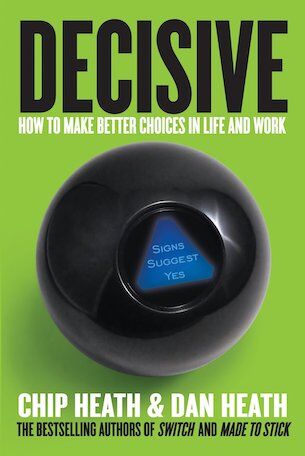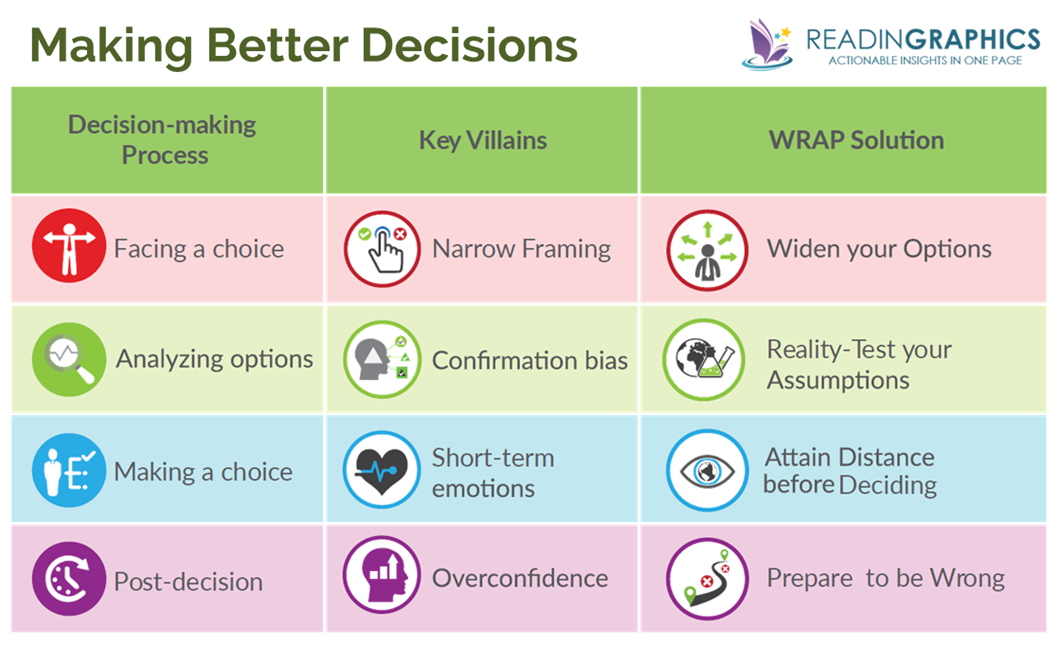
Safe Systems President Darren Bridges always has the best suggestions for professional development resources, so we decided to introduce “Darren’s Corner” so that everyone can benefit!
Featured Book for February:
“Decisive” by Chip Heath and Dan Heath
 This month in Darren’s Corner we’ll be discussing "Decisive" by Chip Heath and Dan Heath. Decisive is an examination of the decision-making process and the many unconscious biases that shape our thought processes. There are some very common “villains” that work against making the best decisions. We’ve all used them, and until you are aware of them it’s difficult to stop. Decisive helps call attention to these biases.
The four common decision-making errors or “villains” are:
This month in Darren’s Corner we’ll be discussing "Decisive" by Chip Heath and Dan Heath. Decisive is an examination of the decision-making process and the many unconscious biases that shape our thought processes. There are some very common “villains” that work against making the best decisions. We’ve all used them, and until you are aware of them it’s difficult to stop. Decisive helps call attention to these biases.
The four common decision-making errors or “villains” are:
- Narrow Framing – Narrowing options to “this” or “that”
- Confirmation Bias – Seeking out information that agrees with what we already believe
- Short-Term Emotion – Making decisions based on our current emotion without considering the long-term effects
- Overconfidence
- W – Widen your options
- R – Reality-test your assumptions
- A – Attain distance before deciding
- P – Prepare to be wrong
W – Widen your options
Widening your options helps overcome the first villain, narrow framing. We can do this by avoiding black and white thinking and “one or the other” questions, like “Should we invest in this new technology or not?” In reality, there may be several options in the gray area. In the technology example, perhaps rather than investing in the new technology you might consider upgrading some of your existing solutions. It’s easy to get hung on those limiting questions and limiting choices – but that hurts our decision making. Some strategies to overcome this include:- Look for other options
- Reframe the question
- Use the vanishing option test, i.e., “if this were no longer an option, what would I do?”
- Consider multiple options at once, not just the two most obvious choices.
R - Reality-Test Your Assumptions
Rather than seeking out information that confirms what we already believe, it’s important to get the full picture by reality-testing assumptions. Some strategies to overcome this include:- Encourage dissenting opinions Darren believes it is important to ensure that everyone in an organization feels comfortable sharing opinions that differ from his own. One strategy he uses to encourage this is to ask people to “prove him wrong.”
- Ask disconfirming questions, like, “What problems does my idea have?”
- Ask yourself, “what if the opposite of what I believe were true?”
- Revisit decisions
A - Attain Distance Before Deciding
Emotions are an important part of decision making (we can’t make good decisions without them), but short-term emotion can also hurt us. Whether you’re holding onto fears from a previous decision or are concerned about how a decision will reflect on you, short-term emotion can cloud your decision-making ability. Some strategies to overcome this include:- Attain distance. This can refer to physical or even time-based distance. Removing yourself from a situation where there is heightened emotion is a good way to calm down and think about the decision from a refreshed perspective.
- Ask yourself, “if I do this (or that), how will I feel about it in 10 minutes, 10 months, and 10 years?” This is referred to as the “10/10/10” method.
- Ask yourself, “if my coworker/boss/friend came to me with this decision, how would I advise them?”
- Focus on your core priorities and make the decision that supports your main priority
P - Prepare to be wrong
Since we can’t predict the future, it’s important to have strategies in place to handle being wrong. By fully preparing the possibility of failure ahead of time, you can prevent yourself from entering a spiral of regret. Some strategies to overcome this include:- Conduct a “premortem” by imagining it is one year later and your decision didn’t end well. What are possible reasons it didn’t end well? Where will you go from here?
- Do a “preparade,” which is like a premortem except preparing for the possibility that your decision is a huge success. Why was it successful? What are next steps? How can we apply this to other situations?
- Include a buffer, whether technical, budgetary, or otherwise, to try and circumvent potential issues
- Anticipate problems. Have a group discussion about the worst possible scenario. Can any of those potential problems be prevented?
- Revisit the decision later. As we mentioned before, it’s important to continuously reexamine decisions and check in with everyone involved.

Image Source: https://readingraphics.com/book-summary-decisive/

